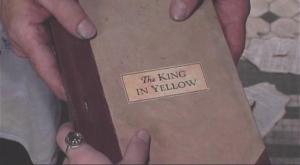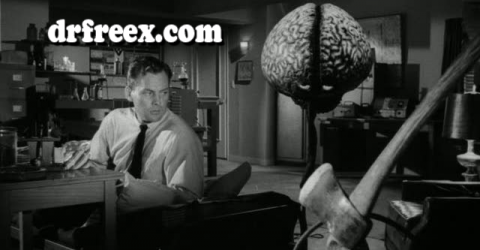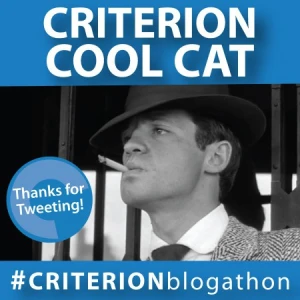Click the banner for Hubrisween Central. Or visit Hubrisween on Letterboxd
 Making movies from established classic literature is a tricky business. Making one from established classic horror literature even more so. It takes a sure, subtle author’s touch to make you look up from a book and make sure no Damned Thing has slithered into the room while you were absorbed in the story. You’d think that would be easier with a movie, all visuals and sound, but no, it’s harder. Literature has the power to make your mind, your imagination work against your own well-being. Few movies have the art to do that.
Making movies from established classic literature is a tricky business. Making one from established classic horror literature even more so. It takes a sure, subtle author’s touch to make you look up from a book and make sure no Damned Thing has slithered into the room while you were absorbed in the story. You’d think that would be easier with a movie, all visuals and sound, but no, it’s harder. Literature has the power to make your mind, your imagination work against your own well-being. Few movies have the art to do that.
To my knowledge, this is the only serious attempt to bring one of Robert W. Chambers’ seminal horror stories to life, and even so writer/director Aaron Vanek is sure to mention that it is “inspired by”. The Yellow Sign is the fourth story in the book, The King in Yellow, which was spoken of in reverent terms in my youth. There was a resurgence of interest in H.P. Lovecraft in the late 60s and early 70s, and I don’t think his stories have gone out of print since; therefore attention was paid to his influences, and Chambers most definitely is one.
 The movie first: Tess Reardon (Shawna Waldron) is the owner of a near-bankrupt art gallery. She’s having trouble sleeping, plagued by dreams of weird art, a girl sleeping in a chair covered in yellow and purple ribbons who won’t wake up, dreams always ended by a large man with empty eyes asking “Have you found the yellow sign?” Her gallery partner (Andrea Gall) says the art sounds like the work of a surrealist shown at her former gallery years before – Aubrey Scott. That show didn’t end well, she says, and Scott has been a recluse ever since.
The movie first: Tess Reardon (Shawna Waldron) is the owner of a near-bankrupt art gallery. She’s having trouble sleeping, plagued by dreams of weird art, a girl sleeping in a chair covered in yellow and purple ribbons who won’t wake up, dreams always ended by a large man with empty eyes asking “Have you found the yellow sign?” Her gallery partner (Andrea Gall) says the art sounds like the work of a surrealist shown at her former gallery years before – Aubrey Scott. That show didn’t end well, she says, and Scott has been a recluse ever since.
Tess tracks Scott (Dale Snowberger) to an old, seemingly empty hotel. His apartments have become a riot of his work, compelling but dark. He agrees to a show, but only if Tess will model for his new painting. She quickly agrees.
 While painting, Scott tells Tess a story to stop her from fidgeting. It’s about a tribe where the children seem to go mad for several years, but they are really existing in two worlds simultaneously, and when this period is over, they became the tribe’s shamen. The combination of Scott’s story and a swirling painting before her causes Tess to lapse into a trance, as the Yellow Sign appears on the canvas. In the trance she refers to Scott as “Aldones” – “You know my real name!” he gasps – and informs him the Watchman is coming for him. Panicking, Scott wakes her. She thinks she was asleep.
While painting, Scott tells Tess a story to stop her from fidgeting. It’s about a tribe where the children seem to go mad for several years, but they are really existing in two worlds simultaneously, and when this period is over, they became the tribe’s shamen. The combination of Scott’s story and a swirling painting before her causes Tess to lapse into a trance, as the Yellow Sign appears on the canvas. In the trance she refers to Scott as “Aldones” – “You know my real name!” he gasps – and informs him the Watchman is coming for him. Panicking, Scott wakes her. She thinks she was asleep.
The tenor of her dreams change. Now the large man is driving a carriage under her window. It’s a hearse, and Scott is in the coffin, screaming to be let out.
 The next modeling session, Tess tells the painter about her childhood, and an invisible twin sister she had called Camilla. Not an imaginary friend, a real person, who was queen of a place called Ythll. Tess doesn’t realize that her childhood mirrors the story Scott had told her before. And as she leaves that day, he hands her a copy of a book: The King in Yellow, Though she tries to throw it away when she is halfway through, it comes back to her. She finishes it, and the next day, the signing of the contract with Aubrey Scott takes on a much more unearthly and deadly significance.
The next modeling session, Tess tells the painter about her childhood, and an invisible twin sister she had called Camilla. Not an imaginary friend, a real person, who was queen of a place called Ythll. Tess doesn’t realize that her childhood mirrors the story Scott had told her before. And as she leaves that day, he hands her a copy of a book: The King in Yellow, Though she tries to throw it away when she is halfway through, it comes back to her. She finishes it, and the next day, the signing of the contract with Aubrey Scott takes on a much more unearthly and deadly significance.
This sent me scurrying to my copy of The King in Yellow (the story collection, thankfully not the book in the story) to see exactly how “inspired by” was this version. Vanek’s changes are intriguing. Chambers’ story concerns a painter and his model, and the large man who lurks around the graveyard across the street from his studio, whom he describes as looking “Like a coffin worm”. His model has the dream about the coffin in the hearse, and so it goes. The movie is basically a reverse of the story, which is told from the painter’s point of view. The movie unfolds from the model’s POV, and while the ending differs greatly, well – that’s all the better for people who read the story, I suppose. It does impose a sort of order and reason on the denouement, which was pretty creepy and inexplicable in the original.
 It’s Chambers’ refusal to explain the supernatural goings-on that so inspired Lovecraft along with that device, the evil book. The King in Yellow is a play script, a script that, if read, drives people to madness and death. Apparently the first act is quite normal; but the second act reveals several awful truths about life and the universe around us that are better left unknown.
It’s Chambers’ refusal to explain the supernatural goings-on that so inspired Lovecraft along with that device, the evil book. The King in Yellow is a play script, a script that, if read, drives people to madness and death. Apparently the first act is quite normal; but the second act reveals several awful truths about life and the universe around us that are better left unknown.
That, of course, is next to impossible to get across in a movie. So Vanek, probably wisely, chose not to, changing The King in Yellow to the key that unlocks the mystery of what Aubrey Scott has been up to with these strange paintings (as only a slight digression, the Art Direction by Lisa Horn and paintings by Jason Voss are truly outstanding). That is concrete enough, that is do-able, it is even satisfying. Chambers did not carry on with horrific literature, his writing went to other genres over his lifetime. He’d probably be satisfied with the result.
 At a sleek 50 minutes, The Yellow Sign doesn’t get a chance to wear out its welcome, but that also seems to have worked against it. It’s only available commercially in a somewhat hard-to-find disc called The Weird Tale Collection. That’s a pity, because it manages to get its desired effect without any of what seem to be the staples of modern horror cinema, like gore, nudity or sudden blaring loud sounds.
At a sleek 50 minutes, The Yellow Sign doesn’t get a chance to wear out its welcome, but that also seems to have worked against it. It’s only available commercially in a somewhat hard-to-find disc called The Weird Tale Collection. That’s a pity, because it manages to get its desired effect without any of what seem to be the staples of modern horror cinema, like gore, nudity or sudden blaring loud sounds.



